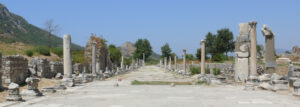Books in Brief: Egyptian and Jewish MSS, Biblical Archaeology Review (13:3), May/Jun 1987.

Ephesus. By Ad Meskens – Own work, CC BY-SA 3.0, https://commons.wikimedia.org/w/index.php?curid=8905604
Edited by Hans Dieter Betz
(Chicago- University of Chicago Press, 1986) 339 pp., $39.95
Genizah Manuscripts of Palestinian Targum to the Pentateuch, 2 Volumes
Michael L. Klein
(Cincinnati- Hebrew Union College Press, 1986) Volume I, 363 pp.; Volume II, 131 pp., plus 182 plates, $100.00
Few devotees of Biblical Archaeology Review will want to read these two books. Yet they are important to know about. They represent the laborious, painstaking, detailed efforts of scholars to make available to their colleagues reliable texts of primary ancient documents. Other scholars can then use these texts in their own work—to draw inferences in a variety of ways, especially when these texts are understood in the light of other available materials known to one scholar or another. Such is the task of scholarship.
The first of these books, edited by Hans Dieter Betz of the University of Chicago, is a new edition of magical papyri dating from the second century B.C. to the fifth century A.D., mostly Greek, but also some in demotic (a form of cursive Egyptian) and Coptic, translated into English by a team of 16 distinguished scholars.
From literary sources we know that large numbers of magical books existed in antiquity. For example, in Acts 19-19 (inaccurately cited in Betz’s book), we learn that when Paul was in Ephesus effecting miraculous cures in Jesus’ name, “a number of those who practiced magical arts brought their books together and burned them in the sight of all; and they counted the value of them and found it came to 50,000 pieces of silver.”



